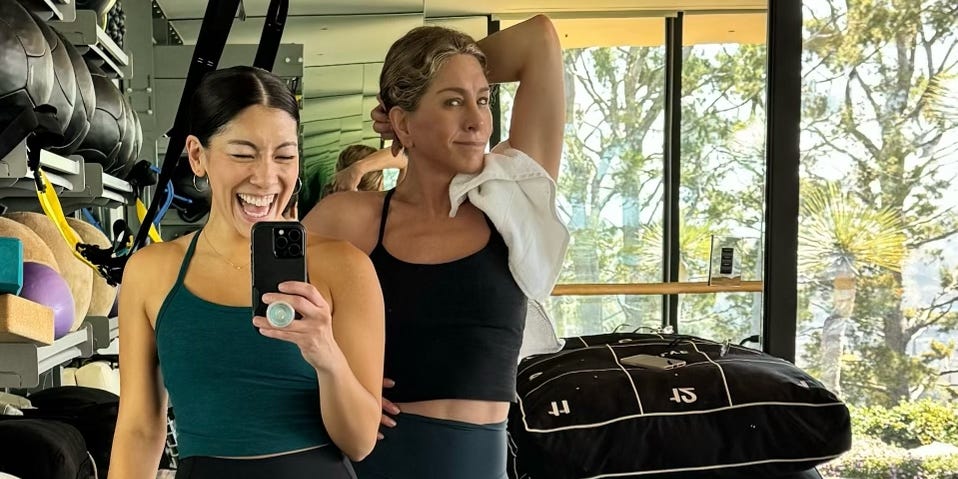When personal trainer Dani Coleman got an email in 2021 about working with Jennifer Aniston, she assumed it had to be a prank. She had never worked with a celebrity before.
“It was definitely a ‘pinch me’ moment,” Coleman, the director of training at fitness company Pvolve, told Business Insider.
It was, in fact, the Jennifer Aniston: star of “Friends,” Primetime Emmy winner, Hollywood actress-turned-producer.
Coleman told me that Aniston heard about Pvolve through a friend and had been quietly tuning in to livestreamed workouts during the first year of the pandemic. As in-person fitness made a comeback, Aniston reached out to Pvolve’s Los Angeles studio for 1:1 sessions.
Even four and a half years later, Coleman said it still feels surreal to be working with a celebrity three to four times a week. She said Aniston, 56, is an impressive athlete who consistently works hard in the gym, whether she has an hour or 20 minutes to spare in her busy schedule.
“She’s a dream client. It’s just magical working together,” Coleman said.
She said Aniston’s routine takes a three-part approach — weight-lifting with cardio and stability — and is a great template for anyone who supports a longer, healthier life with a few hours in the gym each week.
“I think you can make amazing progress with two full-body workouts a week,” Coleman said. “For the average person, the hardest part is just consistency.”
Progressive strength training for longevity
Resistance exercise to build strength and muscle is a cornerstone of Aniston’s workouts, Coleman said.
Her gym sessions focus on a technique called progressive strength training, which involves gradually increasing the challenge of a workout by adding more weight, sets, or reps — continually pushing the muscles to grow.
Courtesy of Pvolve
Coleman said the workouts incorporate dumbbell weights, which help activate more muscle groups than exercise machines, requiring core strength to help control the weight. If Aniston is traveling, those exercises can be adapted, swapping free weights for a resistance band.
Regardless of which equipment you choose, research suggests weight training is a good idea to improve longevity — preventing frailty, improving metabolic health, and staving off cancer and heart diseases by making the body more resilient.
Progressive overload is key if you want to keep making progress. For best results, track your reps, sets, and weights to ensure you continue to build on your efforts over time without overdoing it.
Plyometric exercises to train the heart
Heart-pumping aerobic exercise is another essential part of Aniston’s workouts, typically in short bursts of high-intensity movement.
Coleman said she uses plyometric exercises, explosive movements that train the body to use fast-switch muscle fibers, in addition to amping up heart rate.
For more joint-friendly options to work around previous injuries (Aniston has had knee surgeries and back problems), Coleman said she includes scaled options, such as a step-up or weighted step-up, instead of a box jump.
Aerobic exercise helps protect your heart as you age, even if you’re only doing short doses of movement at a time, research suggests.
Stability training helps prevent injury
One of Aniston’s strongest attributes in the gym is impressive core strength, Coleman said.
Courtesy of Pvolve
“I haven’t seen a plank this woman can’t do. It’s insane,” Coleman said — whether it’s side planks, sliders, or renegade rows.
But, Coleman said, “There’s a lot that goes into the core outside of just the aesthetics of the core.”
Ultimately, core strength is about stabilizing your body so everything works right — from metabolism to staying nimble as you age. For that, you really need to tap into the stabilizing muscles of the hips and glutes.
Besides plank variations, good exercises for core and stability include good mornings, medicine ball rotations, and single-leg balance drills.
“Training is important at every stage of your life, and it’s awesome to be owning that through different chapters of life,” Coleman said. “It’s all about independence, the quality of life that you’re able to keep for longer.”
Consistency trumps intensity
Aniston previously said she gave up on the “no pain, no gain” approach to working out and stopped pushing herself through long, grueling cardio sessions.
The benefit of working smarter, not harder, is that you’re less likely to burn out or get injured, according to Coleman.
“It’s knowing that, OK, I can get a really great workout, but leave feeling energized and I can consistently do this because my body isn’t breaking down along the way, but still be challenged,” she said.



